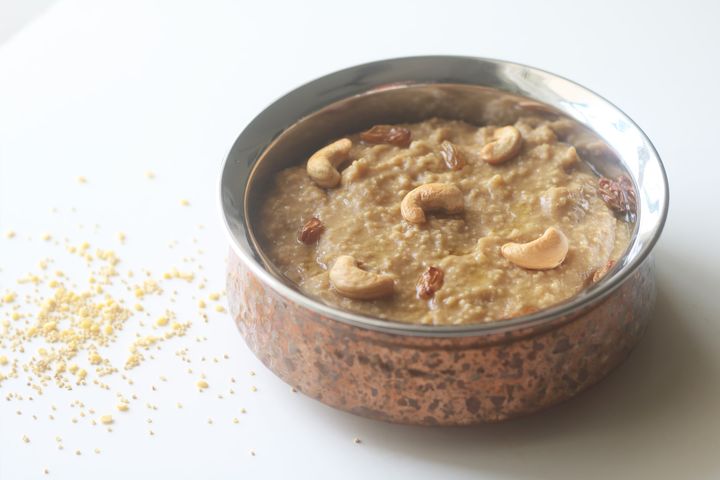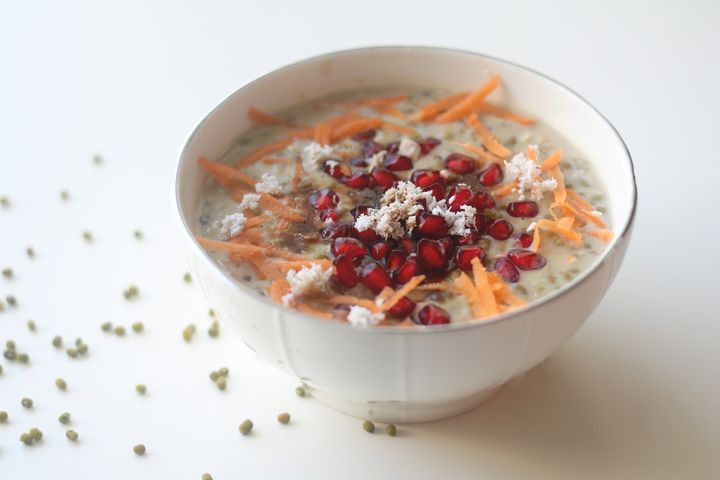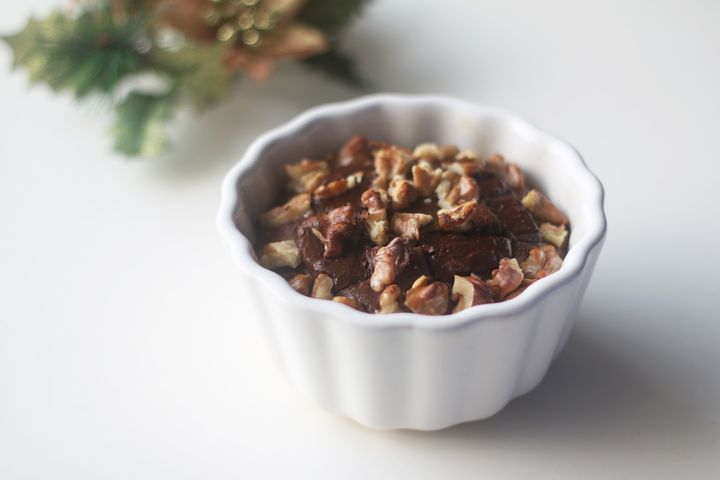Appam Recipe
This South Indian delicacy is a type of pancake made with a fermented rice batter and coconut.
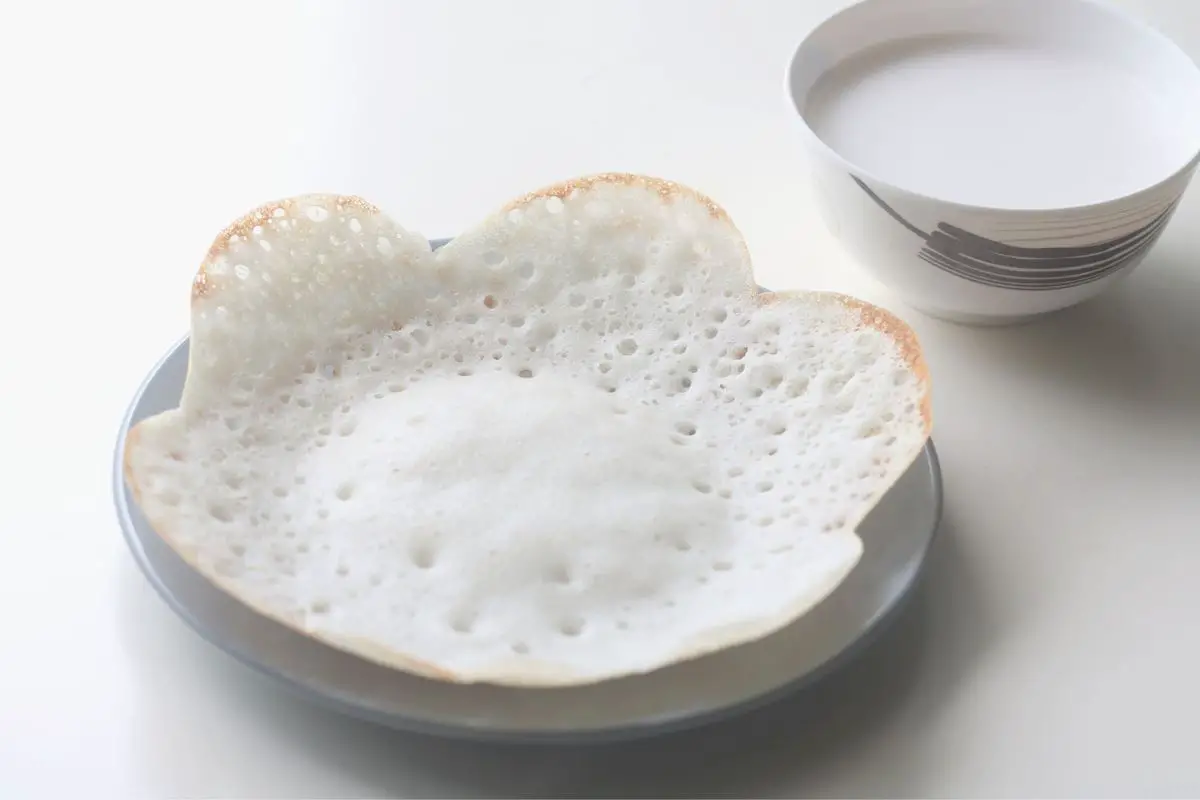
Appam Recipe with step-by-step photos and video. It is one of the most popular breakfast recipes in South India, especially in Tamil Nadu. Usually, people make this appam in round shape. But nowadays, the restaurants serve the appam in flower shape. Hence, I demonstrated how to make the flower-shaped appam in this recipe. So friends, try this out and share your comments!
Introduction
- Welcome to our Appam recipe! This South Indian delicacy is a type of pancake made with a fermented rice batter and coconut. It is known for its soft and fluffy texture, with crispy edges, making it a versatile dish that can be enjoyed with both sweet and savory accompaniments.
- In this post, we will guide you through the step-by-step process of making delicious Appams at home. Whether you’re a seasoned cook or a beginner in the kitchen, this recipe is easy to follow and sure to impress your family and friends. Let’s get started!
What Is Appam Recipe?
- Appam is a traditional South Indian dish thatais made from a combination of idli rice, raw rice, urad dal, and fenugreek seeds. It is known for its unique combination of succulent main ingredients with Indian spices and unique seasoning. This fermented pancake-like dish is a delicious and healthy addition to any meal. Enjoyed with sweetened coconut milk, appam is a must-try dish for anyone looking to explore the flavors of Indian cuisine.
Why You'll Love Appam Recipe?
- Soft and Fluffy Texture: The Appam recipe results in a soft and fluffy texture, making it a delightful addition to any meal. The fermented batter and the use of coconut water create a light and airy consistency that is simply irresistible.
- Healthy and Nutritious: Appam is a healthy option as it is made from a combination of rice and urad dal, which provides essential nutrients and energy. The fermentation process also enhances the nutritional value, making it a wholesome choice for any meal.
- Gluten-Free: For those with gluten sensitivities, this recipe is a perfect choice as it is naturally gluten-free. The use of rice as the main ingredient makes it suitable for those following a gluten-free diet.
- Gut-Friendly: The fermentation process involved in making Appam enhances gut health by promoting the growth of beneficial bacteria. This, in turn, aids in digestion and overall gut health.
- Low in Calories: Appam is a low-calorie option, making it a guilt-free indulgence. The use of minimal oil for cooking also adds to its health benefits, making it a great choice for those looking to manage their weight.
- Versatile and Delicious: Appam can be enjoyed with a variety of accompaniments, from sweetened coconut milk to savory curries, making it a versatile dish that can be tailored to suit anyone's taste preferences.
By incorporating the Appam recipe into your regular cooking, you can enjoy its delightful texture and reap the health benefits it offers.
Ingredients for Appam Recipe
- Idli rice: Idli rice is the main ingredient for making Appam. It adds a soft, fluffy texture to the dish.
- Raw rice: Raw rice is an essential ingredient for Appam, adding a slight crispiness to the edges of the dish.
- Urad dal: Urad dal helps in fermentation and adds a subtle nutty flavor to the batter.
- Fenugreek seeds: Fenugreek seeds add a hint of bitterness and a pleasant aroma to the batter.
- Coconut water: Coconut water adds a subtle sweetness and a refreshing taste to the batter, making the Appam light and delicious.
How To Make Appam Recipe?
To make delicious Appams, follow these simple steps:
- Soaking and Grinding: Wash the Idli rice, raw rice, fenugreek seeds, and urad dal, and then soak them in plenty of water for 5 hours. After 5 hours, grind the soaked rice mixture with enough water until you get a smooth batter.
- Fermentation: Transfer the Appam batter to a bowl, add salt, and mix well. Allow it to ferment for 10 to 12 hours or overnight. This step is crucial for the flavor and texture of the Appams.
- Adjusting the Consistency: After fermentation, adjust the consistency of the batter by adding coconut water and baking soda to make it of pouring consistency like dosa batter. Be mindful not to make it too watery, as it can affect the softness and spread of the Appams.
- Cooking the Appams: Preheat the Appachatty or the Appam pan on medium-high heat. Pour a ladle of batter on the pan and swirl it to spread the batter. Cover the pan with a lid and cook until the Appams are crisp and golden brown on the sides, and the center is steamed and cooked.
- Serving: Remove the Appams from the heat and serve them with sweetened coconut milk for a delightful and flavorful experience.
Following these steps will ensure that you create delicious and authentic Appams every time!
Serving Suggestions
- Sweetened Coconut Milk: Appam pairs perfectly with sweetened coconut milk. The creamy and slightly sweet taste of coconut milk complements the slightly sour and fermented flavor of the appam.
- Egg Curry: For a savory option, try serving appam with a flavorful egg curry. The creamy texture of the curry and the spiced flavors make it a great accompaniment to the soft and fluffy appam.
- Vegetable Stew: Another classic pairing is appam with vegetable stew. The light and fragrant stew made with coconut milk, mixed vegetables, and spices adds a delicious dimension to the appam.
- Chicken Ishtew: If you're a meat lover, chicken ishtew is a great side dish for appam. The mild and creamy coconut-based stew with tender chicken pieces perfectly complements the light and airy appam.
- Chutney: A spicy chutney made with coconut, chili, and spices can also be a great accompaniment to appam. The contrast of flavors adds a kick to the meal.
- Fruit Salad: For a refreshing and light option, serve appam with a side of fruit salad. The freshness of the fruit salad balances the slightly heavy texture of the appam, making it a great combination for breakfast or brunch.

Tips for Making Delicious Appam
- Preparation Duration: Soaking the rice and dal takes 5 hours, and the batter needs to ferment for 10 to 12 hours or overnight. Plan ahead to allow for enough time for the batter to ferment properly.
- For a traditional appam: I use a combination of Idli rice, raw rice, urad dal, and fenugreek seeds. The addition of fenugreek seeds aids in optimal fermentation, resulting in a delightful porous texture. However, if you desire a variation with coconut and poha/aval, simply include ¼ cup of grated coconut and poha while grinding. Alternatively, you can use cooked or steamed rice instead of flattened rice (aval/poha).
- Enhancing Texture with Cooking Soda: To achieve a porous texture, incorporate cooking soda into the batter. Adjust the quantity if needed, especially if the appam doesn't cook evenly in the middle. The key here is to ensure proper fermentation, allowing the cooking soda to react and create those characteristic holes. Adding a bit of eno can also contribute to the desired porous texture, as eno and cooking soda share similar chemical properties.
- Alternative Rice Options: Don't worry if you don't have idli rice; raw rice varieties like sona masoori or ponni rice work just as well. If preferred, drizzle a bit of oil on the sides for added flavor. However, this recipe omits oil, relying on a simple technique of wiping the pan with tissue paper or cloth.
- Cooking Techniques: When pouring the batter into the Appachatty, make sure to swirl the pan to spread the batter evenly. This will ensure that the Appams have a uniform thickness and cook evenly.
- Optimal Batter Consistency: To avoid undercooking in the middle, maintain the right batter consistency. If the batter is too thick, dilute it with coconut water or plain water until it reaches a pouring consistency. Remember to add the water just before making the appam, allowing the batter to be slightly thicker initially. This step ensures a flawless cooking process.
- Garnish for Presentation: Serve the Appams with sweetened coconut milk for a delicious and traditional touch. The garnish not only adds flavor but also enhances the presentation of the dish.
- Adding Sugar: Adding sugar is optional, but it adds a hint of sweetness to the Appams. Adjust the sweetness according to your preference.
By keeping these tips in mind, you can make delicious and perfectly cooked Appams to enjoy with your favorite sides or as a standalone dish.
Variations for Appam Recipe
- Coconut Milk Appam: For a richer flavor, replace some of the coconut water with coconut milk in the batter. This will give the appam a creamy texture and a slightly sweet taste.
- Vegetable Appam: Add finely chopped vegetables like carrots, onions, and bell peppers to the batter for a nutritious twist. It’s a great way to sneak in some extra veggies into your diet.
- Whole Wheat Appam: Replace a portion of the raw rice with whole wheat flour for a healthier version. This will also add a nutty flavor to the appam.
- Savory Appam: Add spices like cumin, black pepper, and green chilies to the batter for a savory kick. This variation pairs well with spicy chutneys or yogurt.
- Jaggery Appam: For a touch of sweetness, replace the sugar with powdered jaggery. This will give the appam a caramel-like flavor and a lovely brown color.
- Banana Appam: Mix in mashed ripe bananas to the batter for a delightful fruity twist. This variation is perfect for a sweet breakfast or a dessert option.
Give these variations a try and let your creativity shine through in the kitchen! Experiment with different ingredients to create your own unique appam experience.
How to Store Appam Recipe
- Proper Storage of Ingredients: It's important to store the idli rice, raw rice, and urad dal in airtight containers to maintain their freshness. Keeping them in a cool, dark place will also help in preserving their quality.
- Store the Appam Batter: After fermenting the appam batter, store it in the refrigerator to maintain its freshness. Make sure to use an airtight container to prevent any moisture from getting in.
- Use Fresh Coconut Water: When adjusting the consistency of the fermented Appam batter, use fresh coconut water. Store bought coconut water may have preservatives which can affect the taste of the appams.
- Keep Baking Soda Fresh: Store the baking soda in a tightly sealed container to prevent it from absorbing any odors from the surroundings. This will ensure its effectiveness in the recipe.
- Protect the Fenugreek Seeds: To maintain the freshness and flavor of the fenugreek seeds, store them in a cool, dry place away from direct sunlight. Airtight containers work best for preserving their quality.
- Check Sugar Quality: If using sugar as an optional ingredient, make sure to store it in a dry, airtight container. This will prevent any clumping and keep it fresh for future use.
By following these simple storage tricks, you can ensure that your appam recipe turns out delicious every time!
Frequently Asked Questions (FAQs)
Can I use regular rice instead of idli rice and raw rice?
- Yes, you can use regular rice as a substitute for idli rice and raw rice. However, the texture and taste may slightly differ from the traditional recipe.
How can I adjust the consistency of the fermented appam batter?
- To adjust the consistency of the fermented appam batter, you can add coconut water and a pinch of baking soda. This will help in achieving the pouring consistency required for making appams.
Can I skip the sugar in the recipe?
- Yes, you can skip the sugar if you prefer a less sweet version of the appam. The sugar is optional and can be adjusted according to your taste preferences.
What can I serve appam with?
- Appam can be served with various accompaniments such as sweetened coconut milk, vegetable stew, chicken curry, or any curry of your choice.
Can I make the batter in advance and store it?
- Yes, you can make the appam batter in advance and store it in the refrigerator for a day or two. Make sure to mix the batter well before using it to make appams.
How can I prevent the appams from turning out too watery?
- To prevent the appams from turning out too watery, make sure not to add too much coconut water while adjusting the consistency of the batter. Additionally, avoid over-fermenting the batter, as it can also lead to a watery texture.
Recipe Card
Serves 5
Prep Time: 15 minutes
Cook Time: 30 minutes
Total Time: 15 hours 30 minutes
Ingredients
- 1 cup Idli rice
- 1 cup raw rice
- 1/4 cup urad dal
- 1 tsp fenugreek seeds
- Salt to taste
- A pinch of baking soda
- 1 tsp sugar (optional)
- Coconut water as needed
Instructions
- Wash Idli rice, raw rice, fenugreek seeds, and urad dal two to three times and then add plenty of water and soak for 5 hours.
- After 5 hours, grind the soaked rice mixture by adding enough water until you get a smooth batter.
- Transfer the Appam batter to a bowl.
- Add salt and mix well by using your hand until well combined.
- Cover the bowl and allow it to ferment for 10 to 12 hours or overnight.
- Adjust the consistency of the fermented Appam batter by adding coconut water and baking soda to make it of pouring consistency like dosa batter or as shown in the video.
- Add sugar and mix well.
- Preheat the Appachatty or the Appam pan on medium high heat. Pour a ladle of batter on the Appachetty and swirl the pan as shown in the video to spread the batter.
- Cover the pan with a lid for approximately 2 minutes until it is crisped and golden brown on the sides and the centre is steamed and cooked.
- Remove from the heat and serve with sweetened coconut milk. Enjoy!
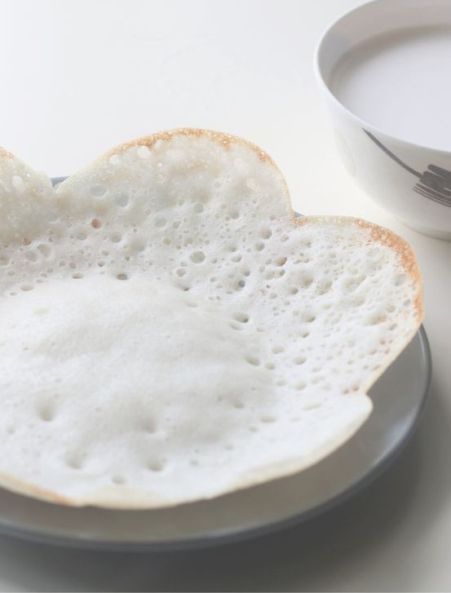
Step-by-Step Instructions:
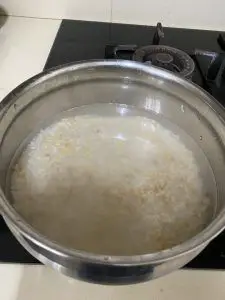
Wash Idli rice, raw rice, fenugreek seeds and urad dal two to three times and then add plenty of water and soak for 5 hours.
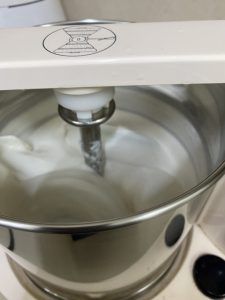
After 5 hours, grind the soaked rice mixture by adding enough water until you get a smooth batter.
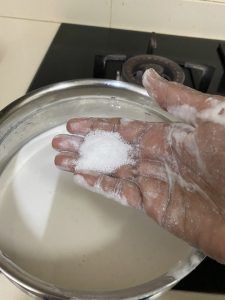
Transfer the Appam batter to a bowl. Add salt and mix well by using your hand until well combined.
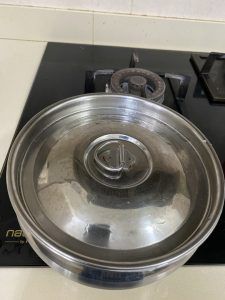
Cover the bowl and allow it to ferment for 10 to 12 hours or overnight.
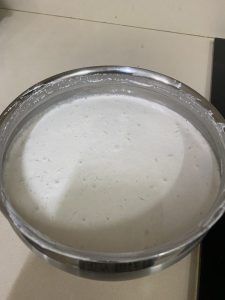
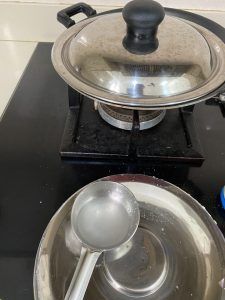
Adjust the consistency of the fermented Appam batter, by adding coconut water and baking soda to make it pouring consistency like dosa batter or as shown in the video.
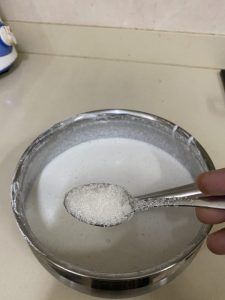
Also, add sugar and mix well until well combined.
You may also like my other Healthy Breakfast posts and recipes like Millets Pongal /Foxtail Millet Sweet Pongal, Mung Bean Porridge, Kara Kuzhi Paniyaram with Idli/Dosa Batter, Oatmeal Brownie, Aval Payasam, Ragi Sweet Kozhukattai, Ragi Paal Kozhukattai, How To Make Soft Layered Chapati, Oat and Honey Chewy No-Bake Granola Bars, Vendhaya Kali, Strawberry Apple Smoothie, Aval Pongal Recipe, Homemade Granola Recipe, Adai Dosa Recipe, Ragi Puttu, Green Gram Payasam/Kheer, Whole Wheat Bread Recipe, Kavuni Arisi Pongal, Vegan Banana Oatmeal Cookies, Homemade Peanut Butter .
